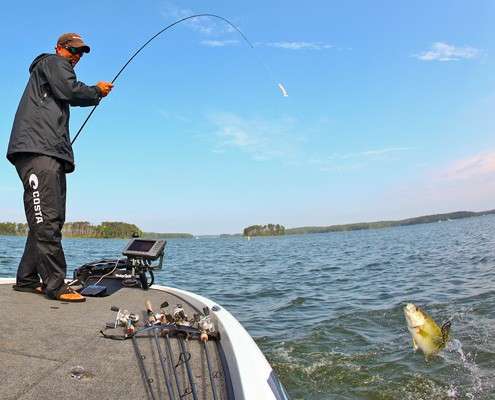
After another angler enters or exits your fishing spot with the loud roar of an outboard motor and the ensuing wake chop, the typical response is a curse word. But, as more and more bass anglers are discovering, “thank you” might be the more appropriate reply.
Bassmaster Elite Series pro Casey Ashley has seen this develop into a fishing tactic on blueback herring lakes, like Clarks Hill, Murray and Hartwell, near his hometown of Donalds, S.C.
“You scatter the bait,” Ashley explained. “A lot of times you’ll see somebody eyeing a point then they’ll take off. Two seconds after they go, the bass come blowing up to the surface because the bait is scattered.
“That is key. I think Brian Snowden was actually doing that at Murray this year. All you’re doing is pushing that bait, and it scatters them. A fish is not going into a ball of bait; he’s going to single one out.”
The more you think about it, the more it makes sense. Ashley is correct in his statement about bass not swimming into a school of baitfish. That’s not how they feed. When a school of bass decides to eat, it is more likely to push the baitfish school to the surface, which acts as a barrier to scatter the baitfish horizontally. Only then do they start feeding.
So you can sit on one spot and wait for the bass’ dinner bell to ring, or you can figure out a way to trigger that feeding response. Ashley has learned several techniques to get this reaction both on blueback herring lakes and those where the dominant forage is shad.
The key is that bass like to feed up. It’s an instinctive response that’s based in the feeding tactic of pushing baitfish to the surface in order to scatter them.
The best time to trigger that reaction on blueback herring lakes is when the baitfish are spawning on very shallow points in May.
“We throw a big Pencil Popper a lot,” Ashley said. “It’s big, and it’s loud. It does two things. It’s either going to catch the biggest fish of the school on the first cast, or, if you don’t get a bite, you’re going to make them come up schooling because it’s so loud it scatters the bait.
“It’s really good for team trails. The man in the front can throw a Pencil Popper, then the guy in the back can follow up with a Gunfish or a Fluke. It’s a deadly combination.”
Ashley has learned variations of this technique on lakes that don’t have blueback herring in them. The principle is the same – doing something to break up a ball of shad, or at least to simulate that situation.
“I love to fish out (deep), and I like to flip a jig,” Ashley said. “In the summertime, you can get way back in a creek on a flat; it might have a ditch running through it, some stumps, some brushpiles. You can flip a jig in there all day and you won’t get bit sometimes. But if you take a buzzbait or some kind of walking bait — something to throw on top of them — they’ll crush it.
“When the water gets warm, the fish love to feed up. It gets even better in August and September but that’s where a lot of guys mess up. They break out the shaky heads when it gets tough. You’re not going to get many bites that way, and you’ll catch a lot more big ones on a topwater.”
Big topwater baits – on a smaller scale – produce the same effect as a boat plowing through a baitfish school; they break up the school allowing bass to pick out a single target to feed upon.
“Whatever you’re throwing – a big buzzbait or a Super Spook – it doesn’t have to be what they’re keying on,” Ashley said. “It doesn’t ‘match the hatch,’ but it’s making the bait move. All you’re doing is isolating one bait to make them start feeding. That’s just what it takes.
“You can go in a creek in the afternoon in the summertime and see balls of bait everywhere. When you let your trolling motor down, you’ll see them go. And then some bass come up schooling. The sound of letting your trolling motor down makes the bait scatter, and bass come up. That’s all you’re doing with a topwater bait. It’s not really what they’re keying on but that you’re making something move.”
There’s never a time in the summer, even on the hottest days, when you can’t be successful on a topwater lure, if you’re throwing it where it can scatter baitfish, according to Ashley.
“A lot of guys will not throw it in the middle of the day,” Ashley said. “I always catch the bigger fish on topwater from Noon to two because, if you think about it, that fish is up there at that time for only one reason – because he’s feeding.
“You might not get as many bites, but you can cover more water and put yourself in position to be at the right spot at the right time.”
The lesson here is simple: It’s easier to be at the right spot at the right time, if you help create that situation by scattering baitfish.




